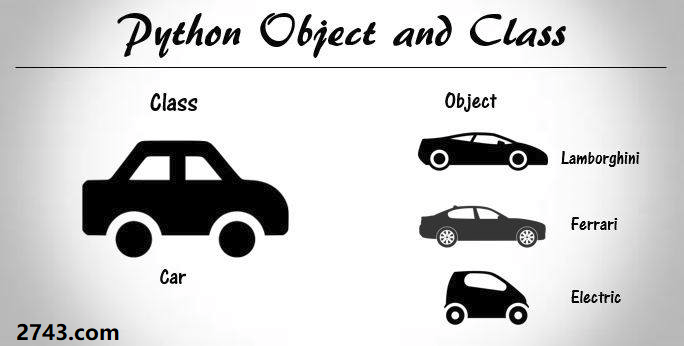在本教程中,您将借助示例来学习 Python 中的面向对象编程(OOP)及其基本概念。

面向对象编程
Python 是一种多范式编程语言。 它支持不同的编程方法。
解决编程问题的一种流行方法是创建对象。 这就是所谓的面向对象编程(OOP)。
对象具有两个特征:
- 属性
- 行为
让我们举个例子:
鹦鹉可以是一个对象,因为它具有以下属性:
- 名称,年龄,颜色作为属性
- 唱歌,跳舞作为行为
Python 中的 OOP 概念专注于创建可重用的代码。 此概念也称为 DRY(不要重复自己)。

在 Python 中,OOP 的概念遵循一些基本原则:
类
类是对象的蓝图。
我们可以将类看作是带有标签的鹦鹉的素描。 它包含有关名称,颜色,大小等的所有详细信息。基于这些描述,我们可以研究鹦鹉。 在这里,鹦鹉是一个对象。
鹦鹉类的示例可以是:
|
1 2 |
<span class="pl-k">class</span> <span class="pl-v">Parrot</span>: <span class="pl-k">pass</span> |
在这里,我们使用class关键字定义一个空类Parrot。 从类中,我们构造实例。 实例是从特定类创建的特定对象。
对象
对象(实例)是类的实例。 定义类时,仅定义对象的描述。 因此,没有分配内存或存储。
鹦鹉类对象的示例可以是:
|
1 |
<span class="pl-s1">obj</span> <span class="pl-c1">=</span> <span class="pl-v">Parrot</span>() |
在此,obj是类别Parrot的对象。
假设我们有鹦鹉的详细信息。 现在,我们将展示如何构建鹦鹉的类和对象。
示例 1:在 Python 中创建类和对象
|
1 2 3 4 5 6 7 8 9 10 11 12 13 14 15 16 17 18 19 20 21 |
<span class="pl-k">class</span> <span class="pl-v">Parrot</span>: <span class="pl-c"># class attribute</span> <span class="pl-s1">species</span> <span class="pl-c1">=</span> <span class="pl-s">"bird"</span> <span class="pl-c"># instance attribute</span> <span class="pl-k">def</span> <span class="pl-en">__init__</span>(<span class="pl-s1">self</span>, <span class="pl-s1">name</span>, <span class="pl-s1">age</span>): <span class="pl-s1">self</span>.<span class="pl-s1">name</span> <span class="pl-c1">=</span> <span class="pl-s1">name</span> <span class="pl-s1">self</span>.<span class="pl-s1">age</span> <span class="pl-c1">=</span> <span class="pl-s1">age</span> <span class="pl-c"># instantiate the Parrot class</span> <span class="pl-s1">blu</span> <span class="pl-c1">=</span> <span class="pl-v">Parrot</span>(<span class="pl-s">"Blu"</span>, <span class="pl-c1">10</span>) <span class="pl-s1">woo</span> <span class="pl-c1">=</span> <span class="pl-v">Parrot</span>(<span class="pl-s">"Woo"</span>, <span class="pl-c1">15</span>) <span class="pl-c"># access the class attributes</span> <span class="pl-en">print</span>(<span class="pl-s">"Blu is a {}"</span>.<span class="pl-en">format</span>(<span class="pl-s1">blu</span>.<span class="pl-s1">__class__</span>.<span class="pl-s1">species</span>)) <span class="pl-en">print</span>(<span class="pl-s">"Woo is also a {}"</span>.<span class="pl-en">format</span>(<span class="pl-s1">woo</span>.<span class="pl-s1">__class__</span>.<span class="pl-s1">species</span>)) <span class="pl-c"># access the instance attributes</span> <span class="pl-en">print</span>(<span class="pl-s">"{} is {} years old"</span>.<span class="pl-en">format</span>( <span class="pl-s1">blu</span>.<span class="pl-s1">name</span>, <span class="pl-s1">blu</span>.<span class="pl-s1">age</span>)) <span class="pl-en">print</span>(<span class="pl-s">"{} is {} years old"</span>.<span class="pl-en">format</span>( <span class="pl-s1">woo</span>.<span class="pl-s1">name</span>, <span class="pl-s1">woo</span>.<span class="pl-s1">age</span>)) |
输出
|
1 2 3 4 |
<span class="pl-v">Blu</span> <span class="pl-c1">is</span> <span class="pl-s1">a</span> <span class="pl-s1">bird</span> <span class="pl-v">Woo</span> <span class="pl-c1">is</span> <span class="pl-s1">also</span> <span class="pl-s1">a</span> <span class="pl-s1">bird</span> <span class="pl-v">Blu</span> <span class="pl-c1">is</span> <span class="pl-c1">10</span> <span class="pl-s1">years</span> <span class="pl-s1">old</span> <span class="pl-v">Woo</span> <span class="pl-c1">is</span> <span class="pl-c1">15</span> <span class="pl-s1">years</span> <span class="pl-s1">old</span> |
在上面的程序中,我们创建了一个名为Parrot的类。 然后,我们定义属性。 属性是对象的特征。
这些属性在类的__init__方法中定义。 创建对象后,首先运行的是初始化方法。
然后,我们创建Parrot类的实例。 这里,Blu和woo是我们新对象(值)的引用。
我们可以使用__class__.species访问class属性。 类的所有实例的类属性都相同。 同样,我们使用blu.name和blu.age访问实例属性。 但是,类的每个实例的实例属性都不同。
要了解有关类和对象的更多信息,请转到 Python 类和对象
方法
方法是在类主体内定义的函数。 它们用于定义对象的行为。
示例 2:在 Python 中创建方法
|
1 2 3 4 5 6 7 8 9 10 11 12 13 14 15 16 17 18 19 20 |
<span class="pl-k">class</span> <span class="pl-v">Parrot</span>: <span class="pl-c"># instance attributes</span> <span class="pl-k">def</span> <span class="pl-en">__init__</span>(<span class="pl-s1">self</span>, <span class="pl-s1">name</span>, <span class="pl-s1">age</span>): <span class="pl-s1">self</span>.<span class="pl-s1">name</span> <span class="pl-c1">=</span> <span class="pl-s1">name</span> <span class="pl-s1">self</span>.<span class="pl-s1">age</span> <span class="pl-c1">=</span> <span class="pl-s1">age</span> <span class="pl-c"># instance method</span> <span class="pl-k">def</span> <span class="pl-en">sing</span>(<span class="pl-s1">self</span>, <span class="pl-s1">song</span>): <span class="pl-k">return</span> <span class="pl-s">"{} sings {}"</span>.<span class="pl-en">format</span>(<span class="pl-s1">self</span>.<span class="pl-s1">name</span>, <span class="pl-s1">song</span>) <span class="pl-k">def</span> <span class="pl-en">dance</span>(<span class="pl-s1">self</span>): <span class="pl-k">return</span> <span class="pl-s">"{} is now dancing"</span>.<span class="pl-en">format</span>(<span class="pl-s1">self</span>.<span class="pl-s1">name</span>) <span class="pl-c"># instantiate the object</span> <span class="pl-s1">blu</span> <span class="pl-c1">=</span> <span class="pl-v">Parrot</span>(<span class="pl-s">"Blu"</span>, <span class="pl-c1">10</span>) <span class="pl-c"># call our instance methods</span> <span class="pl-en">print</span>(<span class="pl-s1">blu</span>.<span class="pl-en">sing</span>(<span class="pl-s">"'Happy'"</span>)) <span class="pl-en">print</span>(<span class="pl-s1">blu</span>.<span class="pl-en">dance</span>()) |
输出:
|
1 2 |
<span class="pl-v">Blu</span> <span class="pl-s1">sings</span> <span class="pl-s">'Happy'</span> <span class="pl-v">Blu</span> <span class="pl-c1">is</span> <span class="pl-s1">now</span> <span class="pl-s1">dancing</span> |
在上面的程序中,我们定义了两种方法,即sing()和dance()。 这些称为实例方法,因为它们是在实例对象(即blu)上调用的。
继承
继承是一种创建新类以使用现有类的详细信息而不进行修改的方法。 新形成的类是派生类(或子类)。 同样,现有类是基类(或父类)。
示例 3:在 Python 中使用继承
|
1 2 3 4 5 6 7 8 9 10 11 12 13 14 15 16 17 18 19 20 21 22 23 24 25 26 27 28 29 30 |
<span class="pl-c"># parent class</span> <span class="pl-k">class</span> <span class="pl-v">Bird</span>: <span class="pl-k">def</span> <span class="pl-en">__init__</span>(<span class="pl-s1">self</span>): <span class="pl-en">print</span>(<span class="pl-s">"Bird is ready"</span>) <span class="pl-k">def</span> <span class="pl-en">whoisThis</span>(<span class="pl-s1">self</span>): <span class="pl-en">print</span>(<span class="pl-s">"Bird"</span>) <span class="pl-k">def</span> <span class="pl-en">swim</span>(<span class="pl-s1">self</span>): <span class="pl-en">print</span>(<span class="pl-s">"Swim faster"</span>) <span class="pl-c"># child class</span> <span class="pl-k">class</span> <span class="pl-v">Penguin</span>(<span class="pl-v">Bird</span>): <span class="pl-k">def</span> <span class="pl-en">__init__</span>(<span class="pl-s1">self</span>): <span class="pl-c"># call super() function</span> <span class="pl-en">super</span>().<span class="pl-en">__init__</span>() <span class="pl-en">print</span>(<span class="pl-s">"Penguin is ready"</span>) <span class="pl-k">def</span> <span class="pl-en">whoisThis</span>(<span class="pl-s1">self</span>): <span class="pl-en">print</span>(<span class="pl-s">"Penguin"</span>) <span class="pl-k">def</span> <span class="pl-en">run</span>(<span class="pl-s1">self</span>): <span class="pl-en">print</span>(<span class="pl-s">"Run faster"</span>) <span class="pl-s1">peggy</span> <span class="pl-c1">=</span> <span class="pl-v">Penguin</span>() <span class="pl-s1">peggy</span>.<span class="pl-en">whoisThis</span>() <span class="pl-s1">peggy</span>.<span class="pl-en">swim</span>() <span class="pl-s1">peggy</span>.<span class="pl-en">run</span>() |
输出:
|
1 2 3 4 5 |
<span class="pl-v">Bird</span> <span class="pl-c1">is</span> <span class="pl-s1">ready</span> <span class="pl-v">Penguin</span> <span class="pl-c1">is</span> <span class="pl-s1">ready</span> <span class="pl-v">Penguin</span> <span class="pl-v">Swim</span> <span class="pl-s1">faster</span> <span class="pl-v">Run</span> <span class="pl-s1">faster</span> |
在以上程序中,我们创建了两个类,即Bird(父类)和Penguin(子类)。 子类继承父类的功能。 我们可以从swim()方法中看到这一点。
再次,子类修改了父类的行为。 我们可以从whoisThis()方法中看到这一点。 此外,我们通过创建新的run()方法来扩展父类的功能。
另外,我们在__init__()方法内使用super()函数。 这使我们可以在子类中运行父类的__init__()方法。
封装形式
在 Python 中使用 OOP,我们可以限制对方法和变量的访问。 这样可以防止数据直接修改(称为封装)。 在 Python 中,我们使用下划线作为前缀来表示私有属性,即单_或双__。
示例 4:Python 中的数据封装
|
1 2 3 4 5 6 7 8 9 10 11 12 13 14 15 16 17 18 19 20 21 |
<span class="pl-k">class</span> <span class="pl-v">Computer</span>: <span class="pl-k">def</span> <span class="pl-en">__init__</span>(<span class="pl-s1">self</span>): <span class="pl-s1">self</span>.<span class="pl-s1">__maxprice</span> <span class="pl-c1">=</span> <span class="pl-c1">900</span> <span class="pl-k">def</span> <span class="pl-en">sell</span>(<span class="pl-s1">self</span>): <span class="pl-en">print</span>(<span class="pl-s">"Selling Price: {}"</span>.<span class="pl-en">format</span>(<span class="pl-s1">self</span>.<span class="pl-s1">__maxprice</span>)) <span class="pl-k">def</span> <span class="pl-en">setMaxPrice</span>(<span class="pl-s1">self</span>, <span class="pl-s1">price</span>): <span class="pl-s1">self</span>.<span class="pl-s1">__maxprice</span> <span class="pl-c1">=</span> <span class="pl-s1">price</span> <span class="pl-s1">c</span> <span class="pl-c1">=</span> <span class="pl-v">Computer</span>() <span class="pl-s1">c</span>.<span class="pl-en">sell</span>() <span class="pl-c"># change the price</span> <span class="pl-s1">c</span>.<span class="pl-s1">__maxprice</span> <span class="pl-c1">=</span> <span class="pl-c1">1000</span> <span class="pl-s1">c</span>.<span class="pl-en">sell</span>() <span class="pl-c"># using setter function</span> <span class="pl-s1">c</span>.<span class="pl-en">setMaxPrice</span>(<span class="pl-c1">1000</span>) <span class="pl-s1">c</span>.<span class="pl-en">sell</span>() |
输出:
|
1 2 3 |
<span class="pl-v">Selling</span> <span class="pl-v">Price</span>: <span class="pl-c1">900</span> <span class="pl-v">Selling</span> <span class="pl-v">Price</span>: <span class="pl-c1">900</span> <span class="pl-v">Selling</span> <span class="pl-v">Price</span>: <span class="pl-c1">1000</span> |
在上面的程序中,我们定义了Computer类。
我们使用__init__()方法存储Computer的最高售价。 我们试图修改价格。 但是,我们无法更改它,因为 Python 将__maxprice视为私有属性。
如图所示,要更改该值,我们必须使用设置器函数,即setMaxPrice(),该函数将价格作为参数。
多态
多态是一种功能(在 OOP 中),可以将公共接口用于多种形式(数据类型)。
假设我们需要为形状着色,有多个形状选项(矩形,正方形,圆形)。 但是,我们可以使用相同的方法为任何形状着色。 这个概念称为多态。
示例 5:在 Python 中使用多态
|
1 2 3 4 5 6 7 8 9 10 11 12 13 14 15 16 17 18 19 20 21 22 23 24 25 26 27 |
<span class="pl-k">class</span> <span class="pl-v">Parrot</span>: <span class="pl-k">def</span> <span class="pl-en">fly</span>(<span class="pl-s1">self</span>): <span class="pl-en">print</span>(<span class="pl-s">"Parrot can fly"</span>) <span class="pl-k">def</span> <span class="pl-en">swim</span>(<span class="pl-s1">self</span>): <span class="pl-en">print</span>(<span class="pl-s">"Parrot can't swim"</span>) <span class="pl-k">class</span> <span class="pl-v">Penguin</span>: <span class="pl-k">def</span> <span class="pl-en">fly</span>(<span class="pl-s1">self</span>): <span class="pl-en">print</span>(<span class="pl-s">"Penguin can't fly"</span>) <span class="pl-k">def</span> <span class="pl-en">swim</span>(<span class="pl-s1">self</span>): <span class="pl-en">print</span>(<span class="pl-s">"Penguin can swim"</span>) <span class="pl-c"># common interface</span> <span class="pl-k">def</span> <span class="pl-en">flying_test</span>(<span class="pl-s1">bird</span>): <span class="pl-s1">bird</span>.<span class="pl-en">fly</span>() <span class="pl-c">#instantiate objects</span> <span class="pl-s1">blu</span> <span class="pl-c1">=</span> <span class="pl-v">Parrot</span>() <span class="pl-s1">peggy</span> <span class="pl-c1">=</span> <span class="pl-v">Penguin</span>() <span class="pl-c"># passing the object</span> <span class="pl-en">flying_test</span>(<span class="pl-s1">blu</span>) <span class="pl-en">flying_test</span>(<span class="pl-s1">peggy</span>) |
输出:
|
1 2 |
<span class="pl-v">Parrot</span> <span class="pl-s1">can</span> <span class="pl-s1">fly</span> <span class="pl-v">Penguin</span> <span class="pl-s1">can</span>'<span class="pl-s1">t</span> <span class="pl-s1">fly</span> |
在上面的程序中,我们定义了两个类别Parrot和Penguin。 它们每个都有一个通用的fly()方法。 但是,它们的功能不同。
要使用多态,我们创建了一个通用接口,即flying_test()函数,该函数接受任何对象并调用该对象的fly()方法。 因此,当我们在flying_test()函数中传递blu和peggy对象时,它有效地运行了。
要记住的要点:
- 面向对象的编程使程序易于理解并且高效。
- 由于该类是可共享的,因此可以重用该代码。
- 数据通过数据抽象是安全的。
- 多态允许相同的接口用于不同的对象,因此程序员可以编写高效的代码。
